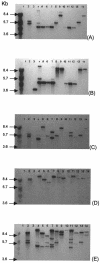Genetic basis of erythromycin resistance in oral bacteria
- PMID: 15155239
- PMCID: PMC415603
- DOI: 10.1128/AAC.48.6.2298-2301.2004
Genetic basis of erythromycin resistance in oral bacteria
Abstract
We determined the prevalence of erythromycin-resistant bacteria in the oral cavity and identified mef and erm(B) as the most common resistance determinants. In addition, we demonstrate the genetic linkage, on various Tn1545-like conjugative transposons, between erythromycin and tetracycline resistance in a number of isolates.
Figures

Similar articles
-
Presence of the tet(O) gene in erythromycin- and tetracycline-resistant strains of Streptococcus pyogenes and linkage with either the mef(A) or the erm(A) gene.Antimicrob Agents Chemother. 2003 Sep;47(9):2844-9. doi: 10.1128/AAC.47.9.2844-2849.2003. Antimicrob Agents Chemother. 2003. PMID: 12936983 Free PMC article.
-
New Tn916-related elements causing erm(B)-mediated erythromycin resistance in tetracycline-susceptible pneumococci.J Antimicrob Chemother. 2007 Jul;60(1):127-31. doi: 10.1093/jac/dkm120. Epub 2007 May 5. J Antimicrob Chemother. 2007. PMID: 17483548
-
erm(B)-carrying elements in tetracycline-resistant pneumococci and correspondence between Tn1545 and Tn6003.Antimicrob Agents Chemother. 2008 Apr;52(4):1285-90. doi: 10.1128/AAC.01457-07. Epub 2008 Feb 19. Antimicrob Agents Chemother. 2008. PMID: 18285489 Free PMC article.
-
Unconstrained bacterial promiscuity: the Tn916-Tn1545 family of conjugative transposons.Trends Microbiol. 1995 Jun;3(6):229-36. doi: 10.1016/s0966-842x(00)88930-1. Trends Microbiol. 1995. PMID: 7648031 Review.
-
Inducible erythromycin resistance in bacteria.Br Med Bull. 1984 Jan;40(1):47-53. doi: 10.1093/oxfordjournals.bmb.a071947. Br Med Bull. 1984. PMID: 6442874 Review. No abstract available.
Cited by
-
Functional screening of a human saliva metagenomic DNA reveal novel resistance genes against sodium hypochlorite and chlorhexidine.BMC Oral Health. 2021 Dec 9;21(1):632. doi: 10.1186/s12903-021-02000-5. BMC Oral Health. 2021. PMID: 34886820 Free PMC article.
-
Influence of azithromycin and clarithromycin on macrolide susceptibility of viridans streptococci from the oral cavity of healthy volunteers.Eur J Clin Microbiol Infect Dis. 2008 Nov;27(11):1087-92. doi: 10.1007/s10096-008-0547-x. Epub 2008 May 30. Eur J Clin Microbiol Infect Dis. 2008. PMID: 18512087 Clinical Trial.
-
Isolation of phages against Streptococcus species in the oral cavity for potential control of dental diseases and associated systemic complications.Arch Microbiol. 2024 Mar 17;206(4):175. doi: 10.1007/s00203-024-03897-6. Arch Microbiol. 2024. PMID: 38493441
-
Repurposing of Tamoxifen Against the Oral Bacteria.Turk J Pharm Sci. 2021 Feb 25;18(1):68-74. doi: 10.4274/tjps.galenos.2019.23500. Turk J Pharm Sci. 2021. PMID: 33634670 Free PMC article.
-
Effects of Erythromycin on Osteoclasts and Bone Resorption via DEL-1 Induction in Mice.Antibiotics (Basel). 2021 Mar 17;10(3):312. doi: 10.3390/antibiotics10030312. Antibiotics (Basel). 2021. PMID: 33803007 Free PMC article.
References
-
- Aracil, B., M. Miñambres, J. Oteo, C. Torres, J. L. Gómez-Garcés, and J. I. Alós. 2001. High prevalence of erythromycin-resistant and clindamycin-susceptible (M phenotype) viridans group streptococci from pharyngeal samples: a reservoir of mef genes in commensal bacteria. J. Antimicrob. Chemother. 48:592-594. - PubMed
-
- Chung, W. O., C. Werckenthin, S. Schwarz, and M. C. Roberts. 1999. Host range of the ermF rRNA methylase gene in bacteria of human and animal origin. J. Antimicrob. Chemother. 43:5-14. - PubMed
Publication types
MeSH terms
Substances
LinkOut - more resources
Full Text Sources
Medical

